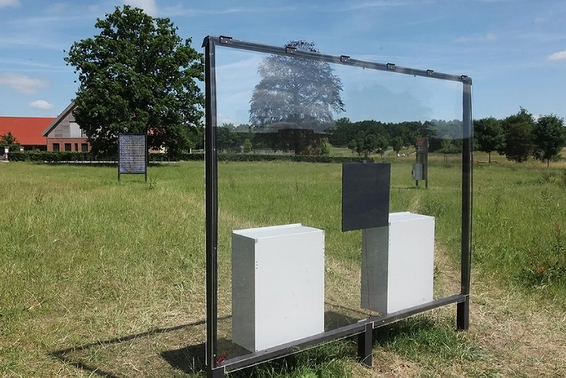
R
E
V N
E
X
T
One of the LED screens that make up Ei Arakawa’s public artwork Harsh Citation, Harsh Pastoral, Harsh Münster (2017), located in a grassy field as part of the Skulptur Projekte in Münster, was stolen on the night of Saturday, June 17. Each screen in the work recreates a painting, ranging from Gustave Courbet’s The Meeting, or Bonjour, Monsieur Courbet (1854) to canvases by Gutai artist Atsuko Tanaka and abstract expressionist Joan Mitchell, and each is accompanied by a song. The work that was stolen was a recreated Jutta Koether painting, though the musical hardware remained in place. Skulptur Projekte Münster announced the theft on its website and said the screen would be replaced in the beginning of July.
Known for his collaborative projects and sense of humor, Arakawa has been making a series of recent works that endowed painting with performative elements—such as putting them on wheeled structures, recreating them in LED lights or setting them to music. Harsh Citation, Harsh Pastoral, Harsh Münster combined many of these elements, so that the paintings and their songs formed a chorus. Showing great equanimity after his work was stolen, Arakawa commented in an email sent to ArtAsiaPacific that he found the theft to be “a really interesting ‘performance’ . . . revealing how vulnerable art in public space can be, and how public space can be violent,” pointing out that “this often happens in the history of Skulptur Projekte.” In the same email, he revealed details of the prank-like crime. The plexiglass case in which the screen was located was removed with an electric screwdriver, and the LED panel, which measures 2-by-2.5 meters, was carried off, presumably by more than one person. Why vandals had carted off this particular painting was unclear. Police had been notified and were searching for witnesses.
Arakawa situated the LED screens of Harsh Citation, Harsh Pastoral, Harsh Münster near Lake Aa and Haus Kump, one of the oldest settlements of Münster. The replacement work will be made with a black PVC sheet instead of a hand-dyed fabric like the original, in part for expediency and in part because Arakawa said he wants to incorporate the theft as part of the work that visitors will encounter. Artworks in past editions of Skulptur Projekte Münster have previously been targeted, as Arakawa had noted. Katharina Fritsch’s copy of the Lourdes Madonna in a lurid yellow upset pious residents of the Catholic city, some of whom smashed its hands. Lara Favaretto’s contribution to this year’s edition, a giant stone block with a hole in which people can make donations to a charity that houses refugees slated to be deported, will be smashed at the end of the festival so that the money can be retrieved. Fortunately, other than the stolen panel, Arakawa’s work remains in operation. “We are attempting to replace it before July 1st, meanwhile you can enjoy the other 6 LED paintings, one empty metal frame, and songs,” the artist commented.
This edition of Skulptur Projekte Münster runs until October 1, and will not be held again until 2027.
HG Masters is editor-at-large of ArtAsiaPacific.
To read more of ArtAsiaPacific’s articles, visit our Digital Library.



